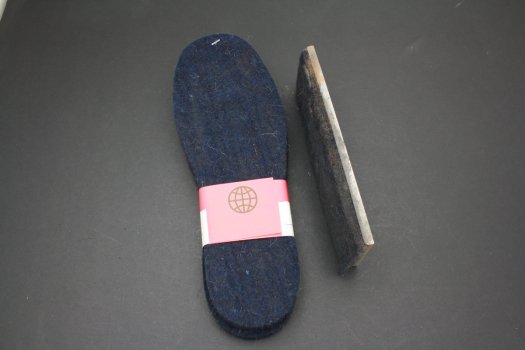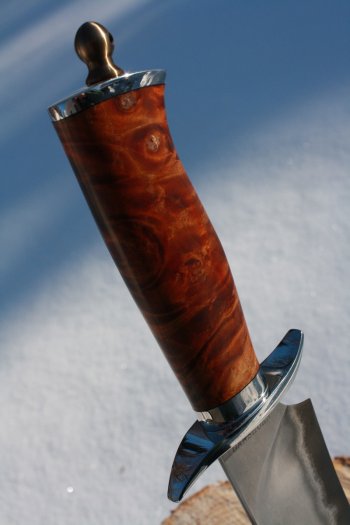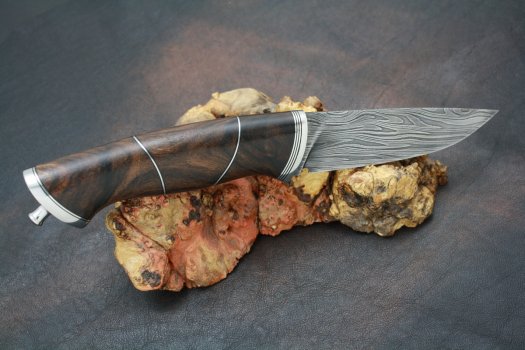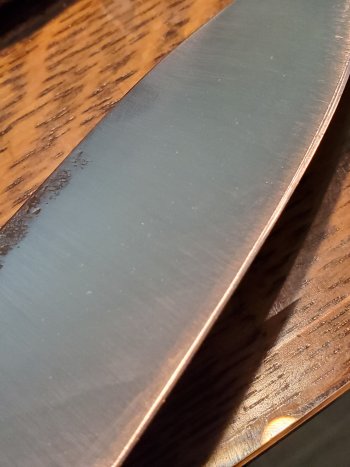You are using an out of date browser. It may not display this or other websites correctly.
You should upgrade or use an alternative browser.
You should upgrade or use an alternative browser.
Felt platen
- Thread starter Gliden07
- Start date
Gliden07
Well-Known Member
I’m going to show my ignorance here, but what would one hope to achieve with a platen covered in softer material?
To make and help blend a Convex grind.
fitzo
Well-Known Member
Grainger sells felt squares at Amazon well suited for this application. Comes in 12x12 sheets in a selection of thickness and hardness (Measured in Fx. F1 is hardest.)
Here is an example.
Here is an example.
Gliden07
Well-Known Member
Grainger sells felt squares at Amazon well suited for this application. Comes in 12x12 sheets in a selection of thickness and hardness (Measured in Fx. F1 is hardest.)
Here is an example.
This is the missing link! THANK YOU!!
REK Knives
Well-Known Member
Sean Jones
Well-Known Member
I'm interested in seeing your setup as well. I've been attempting a slight convex grind on some chef knives and never even thought of a felt platen. Though in the back of my mind I knew about it from reading previous posts and articles.I would be grateful if you were to post a foto of your finished felt platen set up on the grinder and an example of it’s grind somewhere down the line, sir! Thank you.
EdCaffreyMS
"The Montana Bladesmith"
I'm gona throw out a word of warning here. There is a common problem with just about anything you can use for a "soft" type platen face.... that being as you grind, there is either a "wear" or a "crush" factor that you must deal with. What is that? In short, it means that with each grinding pass you make, the radius of the convex the platen face provides... changes, so it's constantly changing the radius, and you are constantly chasing your tail. How much and how fast it changes depends on belt speed and the amount of pressure you apply.
Probably the biggest offender in this realm is the graphite canvas that is sold as a "platen backer" material. Just steer clear of it. You can get MAYBE a 1/2 dozen grinding passes on it, before the graphite is gone, and the canvas is worn to the platen surface.
I'm pleased to hear folks talking felt. In my experience, felt is what I would call the best of the worst material you can choose for a platen face. I've tried layering, but for me it was too inconsistent...as one layer would wear into the next, there is a marked difference in the wear, and any "joint" between layers tends to make "worm tracks" on whatever you're grinding. I settled on a single piece of 1/2" thick "soft" felt from McMaster-Carr. That was before the rotary platen came along.
I've tried a bunch of different things for convex grinding over my career, and to be completely frank, nothing works well, or for very long, EXCEPT.... a rotary platen. It's a bummer that a rotary platen cost so much, but if you're intent is to do a significant amount of convex grinding, it will pay for itself in the frustration it prevents.
Here's the 1/2 felt glued to a platen face...

All of my grinder platens are setup so that I can easily change the "face plates".... just held by two 7/16" bolts.... (just came back and re-read my post... That should have said 1/4" bolts! It the heads that are 7/16"...GEEZ my brain is toast.) the following is the glass faced platen that is what I use about 99% of the time.... then the felt platen face mounted. Trust me, IF you choose to go the felt route, you want it sticking out that much.



As John mentioned below, my felt platen has been around forever.... but never gets used.
Probably the biggest offender in this realm is the graphite canvas that is sold as a "platen backer" material. Just steer clear of it. You can get MAYBE a 1/2 dozen grinding passes on it, before the graphite is gone, and the canvas is worn to the platen surface.
I'm pleased to hear folks talking felt. In my experience, felt is what I would call the best of the worst material you can choose for a platen face. I've tried layering, but for me it was too inconsistent...as one layer would wear into the next, there is a marked difference in the wear, and any "joint" between layers tends to make "worm tracks" on whatever you're grinding. I settled on a single piece of 1/2" thick "soft" felt from McMaster-Carr. That was before the rotary platen came along.
I've tried a bunch of different things for convex grinding over my career, and to be completely frank, nothing works well, or for very long, EXCEPT.... a rotary platen. It's a bummer that a rotary platen cost so much, but if you're intent is to do a significant amount of convex grinding, it will pay for itself in the frustration it prevents.
Here's the 1/2 felt glued to a platen face...

All of my grinder platens are setup so that I can easily change the "face plates".... just held by two 7/16" bolts.... (just came back and re-read my post... That should have said 1/4" bolts! It the heads that are 7/16"...GEEZ my brain is toast.) the following is the glass faced platen that is what I use about 99% of the time.... then the felt platen face mounted. Trust me, IF you choose to go the felt route, you want it sticking out that much.



As John mentioned below, my felt platen has been around forever.... but never gets used.
Last edited:
J. Doyle
Dealer - Purveyor
I'm gona throw out a word of warning here. There is a common problem with just about anything you can use for a "soft" type platen face.... that being as you grind, there is either a "wear" or a "crush" factor that you must deal with. What is that? In short, it means that with each grinding pass you make, the radius of the convex the platen face provides... changes, so it's constantly changing the radius, and you are constantly chasing your tail. How much and how fast it changes depends on belt speed and the amount of pressure you apply.
Probably the biggest offender in this realm is the graphite canvas that is sold as a "platen backer" material. Just steer clear of it. You can get MAYBE a 1/2 dozen grinding passes on it, before the graphite is gone, and the canvas is worn to the platen surface.
I'm pleased to hear folks talking felt. In my experience, felt is what I would call the best of the worst material you can choose for a platen face. I've tried layering, but for me it was too inconsistent...as one layer would wear into the next, there is a marked difference in the wear, and any "joint" between layers tends to make "worm tracks" on whatever you're grinding. I settled on a single piece of 1/2" thick "soft" felt from McMaster-Carr. That was before the rotary platen came along.
I've tried a bunch of different things for convex grinding over my career, and to be completely frank, nothing works well, or for very long, EXCEPT.... a rotary platen. It's a bummer that a rotary platen cost so much, but if you're intent is to do a significant amount of convex grinding, it will pay for itself in the frustration it prevents.
Exactly the reason I made felt and leather platens several years ago......and NEVER use them.
I keep them around because some day, there might be a VERY limited specific use but probably not.
I have heard of, but not personally used, an interesting budget alternative to a rotary platten: get a scotchbright belt made to a custom 2 x 70 size and place it inside your standard grinding belt so they rotate together in the grinder. Presumably the "give" of the inner belt allows for the kind of flexible platten you are looking for. I'll be getting one once I find my note on who makes a custom length scotchbright belt.
MTBob
Well-Known Member
As another alternative to achieving a convex grind without "investing" in a rotary platen, this posting might be useful.
So far, I've found this set up works for me, at my skill level. Keep in mind though, I've never had an actual rotary platen to compare this to. In some respects, this two arm arrangement would appear to be even more flexible in adjusting the belt tension than a fixed rotary platen. When spending money for shop equipment it seems to me that a rotary platen doesn't give enough "Bang for the Buck".
Substitute for a Rotary Platen?`
My wife is beginning to believe that I'm not making knives, just shopping for new tools. Well, that issue came up again while I was considering buying a rotary platen attachment for the 2x72. I see the purpose and have read a bunch of reviews that confirm their usefulness. So, this afternoon...
knifedogs.com
Gliden07
Well-Known Member
I'm sure the rotary platen is the way to go but I'm on a serious budget. Lost job due to Covid so the knife sales have been helping making ends meet. I used the felt at the class I took and it worked GREAT blending in the convex grind on my Chopper (please note this is not my regular finish).
Attachments
Smallshop
KNIFE MAKER
This.In my experience, felt is what I would call the best of the worst material you can choose for a platen face. I've tried layering, but for me it was too inconsistent...as one layer would wear into the next, there is a marked difference in the wear, and any "joint" between layers tends to make "worm tracks" on whatever you're grinding. I settled on a single piece of 1/2" thick "soft" felt from McMaster-Carr. That was before the rotary platen came along.
Haven't bought one yet...it's on the top of the list...
EdCaffreyMS
"The Montana Bladesmith"
That's a screaming good idea for a budget system! I can't say that I understand the scotchbrite needing to be 70".... how would you tighten the 2 x 72" grinding belt? Anyway, it's exactly the principle the rotary platen works off of..... a stiffer backing belt (I think the rotary platens use a belt intended for snowmobiles), with the grinding belt riding atop it.I have heard of, but not personally used, an interesting budget alternative to a rotary platten: get a scotchbright belt made to a custom 2 x 70 size and place it inside your standard grinding belt so they rotate together in the grinder. Presumably the "give" of the inner belt allows for the kind of flexible platten you are looking for. I'll be getting one once I find my note on who makes a custom length scotchbright belt.
I just dug went through my pics and dug these up of my rotary platen. I have all the tooling arms for my grinders, and the attachments set up with a 3/4" pin and socket arrangement, which means I just loosen the handle bolt, and rotate to wherever I need.



Bruce McLeish
Well-Known Member
That is a honkin, stiff looking belt !
FORGE
Well-Known Member
I could not make a quality knife without my felt platten. ( most important tool in my shop )
I do not use it for grinding blades but for handles and accessories like guards and butt caps.
It softens the edges and makes the lines flow together. Try one you will love it.
I also use it when I have a SOFT handle material with stainless pins, an ordinary platten and belt tend to leave high spots where the pins are sitting or if you apply to much grinding pressure gouge out the handle material.
I have even used them on a blade spline where you want a slight rounded effect.
I use it to make pommel nuts by spinning them with a drill into the felt platten.
I found a store that sells felt liners for winter boots and simply glue it to a piece of platen material. When it wears out scrape it off and glue on another piece.




I do not use it for grinding blades but for handles and accessories like guards and butt caps.
It softens the edges and makes the lines flow together. Try one you will love it.
I also use it when I have a SOFT handle material with stainless pins, an ordinary platten and belt tend to leave high spots where the pins are sitting or if you apply to much grinding pressure gouge out the handle material.
I have even used them on a blade spline where you want a slight rounded effect.
I use it to make pommel nuts by spinning them with a drill into the felt platten.
I found a store that sells felt liners for winter boots and simply glue it to a piece of platen material. When it wears out scrape it off and glue on another piece.





